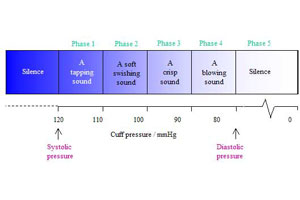![]()
Blog @ SunTech
Advice from the BP Measurement Experts
Back to the Basics of Blood Pressure
 Almost everyone knows that blood pressure is one of the most important measurements in medicine. Every time a patient visits a physician's office or hospital, one of the first measurements taken is their blood pressure. Since blood pressure plays such a vital role in monitoring a person's overall health, I thought I would write about the basics of blood pressure and some of the terminology used in blood pressure measurement.
Almost everyone knows that blood pressure is one of the most important measurements in medicine. Every time a patient visits a physician's office or hospital, one of the first measurements taken is their blood pressure. Since blood pressure plays such a vital role in monitoring a person's overall health, I thought I would write about the basics of blood pressure and some of the terminology used in blood pressure measurement.
- What is Blood Pressure? Blood pressure is the force/pressure of the blood pushing against the walls of the arteries. With each heart beat, blood is being pumped out into our arteries and through out the body.
- What is the difference between systolic and diastolic blood pressure? Blood pressure is always recorded as 2 numbers, such as 120/80, where the top number is the systolic pressure and the bottom number is the diastolic pressure. Systolic pressure is the pressure on the arteries as the heart contracts and pumps blood. The diastolic pressure is the pressure in the arteries when the heart is at rest in between heart beats.
- How is blood pressure measured? When a cuff is wrapped around a patient's upper arm and inflated, the brachial artery is occluded (i.e. blood flow through the artery has been stopped). As the cuff is gradually deflated, blood flow is re-established and accompanied by sounds of "tapping" (thumping) that can be detected with a stethoscope held over the brachial artery just below the cuff. When the first sound of "tapping" is heard, that signifies the systolic pressure and when the "tapping" ceases, that signifies the diastolic pressure.
- What are Korotkoff Sounds? Korotkoff sounds (or K-Sounds) are the "tapping" sounds heard through a stethoscope as the cuff is gradually deflated. Traditionally, these sounds have been classified into five different phases (K-1, K-2, K-3, K-4, K-5) and are shown in the figure below.
- K-1 (Phase 1): The appearance of the clear "tapping" sounds as the cuff is gradually deflated. The first clear "tapping" sound is defined as the systolic pressure.
- K-2 (Phase 2): The sounds in K-2 become softer and longer and are characterized by a swishing sound since the blood flow in the artery increases.
- K-3 (Phase 3): The sounds become crisper and louder in K-3 which is similar to the sounds heard in K-1.
- K-4 (Phase 4): As the blood flow starts to become less turbulent in the artery, the sounds in K-4 are muffled and softer.
- K-5 (Phase 5): In K-5, the sounds disappear completely since the blood flow through the artery has returned to normal. The last audible sound is defined as the diastolic pressure.

http://www.medphys.ucl.ac.uk/teaching/undergrad/projects/2003/group_03/how.html
- What is the Auscultatory method of blood pressure measurement? The auscultatory method (also known as the manual method for blood pressure measurement) is the LISTENING of Korotkoff sounds in the brachial artery. The gold standard for clinical blood pressure measurement has always been to take a blood pressure using the auscultatory method where a trained health care provider uses a sphygmomanometer and listens for the Korotkoff sounds using a stethoscope. However, there are many variables that affect the accuracy of this method and numerous studies have shown that physicians and healthcare providers rarely follow the established guidelines for taking proper manual blood pressure measurements (Pickering et al, 2005). (For more information on the proper technique for manual blood pressure measurements, please download our free ebook "10 Steps to Accurate Manual Blood Pressure Measurement).
- What is the Oscillometric method of blood pressure measurement? The oscillometric method is the MEASURING of the pressure variations in the blood pressure cuff caused by the oscillation of blood flow through the brachial artery. The blood pressure values are then calculated by an empirically derived algorithm. Most automated blood pressure monitors use the oscillometric method for blood pressure since is it less susceptible to external noise.
- What is Mean Arterial Pressure (MAP)? MAP is the average arterial pressure during a single cardiac cycle (i.e. the average blood pressure in the arteries). The equation to calculate MAP is MAP = Diastolic +1/3(Systolic-Diastolic). MAP is a useful measurement since it indicates both overall health and risk for developing various cardiovascular diseases.
- What is hypertension? Hypertension, or high blood pressure, is classified as a blood pressure measurement of 140/90 mmHg or above. According to the American Heart Association, hypertension affects nearly one out of every three Americans. Hypertension is a major risk factor associated with many cardiovascular diseases and plays a significant role in the progression of congestive heart failure, stroke, heart attacks, kidney failure, and premature death. Factors that contribute to the prevalence of hypertension are smoking, stress, drugs, alcohol, nutrition, diabetes, obesity, and limited physical activity.
- When I get my blood pressure taken, what does that measurement mean? There are four different categories that blood pressure readings fall into and are shown in the table below. If your blood pressure measurement falls into two different categories, then you would be placed in the higher blood pressure category (i.e. if your measurement is 130/94, then you would be considered to have Stage 1 Hypertension.)
| Top number (systolic) in mm Hg | Bottom number (diastolic) in mm Hg | Your category* | What to do** | |
| Below 120 | and | Below 80 | Normal blood pressure | Maintain or adopt a health lifestyle |
| 120-139 | or | 80-89 | Prehypertension | Maintain or adopt a healthy lifestyle. If blood pressure goal isn't reached in about six months, talk to your doctor about taking one or more medications. |
| 140-159 | or | 90-99 | Stage 1 hypertension | Maintain or adopt a healthy lifestyle. If blood pressure goal isn't reached in about six months, talk to your doctor about taking one or more medications. |
| 160 or more | or | 100 or more | Stage 2 hypertension | Maintain or adopt a healthy lifestyle. Talk to your doctor about taking more than one medication. |
http://www.mayoclinic.com/health/blood-pressure/HI00043
References:
American Heart Association: Heart Disease and Stroke Statistics - 2010 Update. http://www.americanheart.org/downloadable/heart/1265665152970DS-3241%20HeartStrokeUpdate_2010.pdf
Pickering, T.G., Hall J.E., Appel L.J., Falkner B.E., Graves J., Hill M.N., Jones D.W., Kurtz T., Sheps S.G, Roccella E. J. Recommendations for Blood Pressure Measurement in Humans and Experimental Animals: Part 1: Blood Pressure Measurement in Humans: A Statement for Professionals From the Subcommittee of Professional and Public Education of the American Heart Association Council on High Blood Pressure Research. Hypertension 2005 (45):142-161.
Interested in getting more SunTech news, product info, as well as
tips, tricks, and insights from BP experts?
Sign up to get fresh content delivered direct to your inbox.



